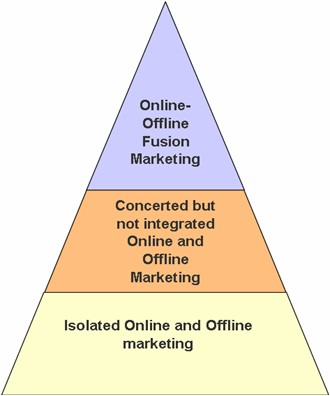The time has come to stop talking about online in isolation of offline. Any separation between the two is a thing of the past since we, as consumers, already live in a fused world. Take a look:
- When you make a purchase—let's say a TV—do you say you bought it at Best Buy-dot-com, or do you just say Best Buy?
- After you see a GEICO commercial on TV, where do you go to check rates?
- How about when you bought your last car? After the research you did online, did you enter your credit card information to have the car shipped to your house? Probably not.
Last year, a study by comScore Networks found that an average of 63% of online searchers who proceeded to complete a purchase did so offline rather than online. Just as online and offline shopping have fused into a single experience, marketers have the opportunity to follow suit by fusing their isolated marketing efforts into a single initiative.
Steps Toward Bridging Online and Offline Marketing
During the past couple of years, you've probably come across many hints on how to bridge gaps between online and offline marketing, such as companies that display unique toll-free telephone numbers online so that calls can be traced back to the user's online activity. However, while many trends have been discussed, it seems that a systematic discussion of online-offline fusion marketing is missing.
Therefore, instead of listing point solutions such as toll-free numbers, let's examine online-offline marketing from a bird's eye perspective to conquer the specific aspects relevant to your business goals.
Online-Offline Fusion Marketing Defined
We can distinguish three sophistication levels of marketing across online and offline channels:
Level 1: Online and Offline Marketing in Isolation
Surely, we all list our Web sites' URLs in every offline ad or brochure. But often promotions available in one channel cannot be redeemed in another. And most of us don't measure the success of a campaign by its impact in both online and offline channels. For example, search engine advertising is often more responsible for generating in-store sales than typically recognized in the metrics.
In fact, many marketing teams work to conduct their respective online and offline metrics separately and often don't share results, or even the credit, with each other.
Level 2: Online and Offline Marketing—Orchestrated but not Integrated
 The next step up the ladder shows marketing initiatives that are concerted but not integrated.
The next step up the ladder shows marketing initiatives that are concerted but not integrated.
A real-world example of this is when a single team of marketers designs advertising campaigns that are orchestrated across online and offline channels—ads can be placed on TV, in newspapers, and in outdoor advertising. The marketers' plan is that customer's will respond via the Web site, call center and stores, and that each of these outlets provides a consistent customer experience.
However, when it comes to measuring results, metrics across channels are listed side-by-side and are not integrated. In addition, no effort is made to measure the behavior of individual prospects as they move across online and offline channels.
Level 3: Online and Offline Fusion Marketing
Fusion marketers expect that prospects and customers will move across online and offline channels as they respond to marketing promotions, and therefore fuse marketing activities with the use of analytics to maximize response and conversion rates.
Fusion marketers can measure the lift of offline activity resulting from online advertising (and vice versa) so that they can continuously tailor their ad investments for increasing returns.
Fusion marketers can also go another step by taking measurements beyond the aggregated level to the level of the individual prospect and customer.
These marketers aim to achieve a competitive advantage by having the ability to provide a relevant experience to individual customers based on their past behavior across online and offline channels.
Goals of the Online-Offline Fusion Marketer
The return on online-offline fusion marketing needs to be measured in terms of increased ROI in your marketing projects across the following categories:
- Acquisition Marketing. Are you able to continuously improve your advertisements and marketing messages by measuring how successful each variation is at attracting prospects to your Web site, your stores, and your call centers?
- Online/Offline Conversion Funnels. Can you increase your conversion rates by providing more relevant experiences to individual customers via online and offline channels, based on the customer's past behavior?
- Event-Based Marketing. Can you act earlier when there is risk of attrition or an opportunity for cross-selling with individual customers by detecting changes in their behavioral pattern on Web sites and in stores?
- Relationship Marketing. Finally, can you increase lifetime value of your customers by fusing all of the above into a single database of actionable marketing profiles for each customer?
Online-Offline Fusion Metrics Form the Basis
Analytics are the defining ingredient behind online-offline fusion marketing. More specifically, the key is to fuse relevant analytics by combining Web analytics with offline analytics.
Such fusion metrics can be calculated at an aggregate level or at the level of the individual customer.
The former makes sense if your goal is to merely measure total ROI across online and offline channels by assessing the lift on one channel attributable to marketing on the other channels.
Measurements at the level of the individual customer make senses if your goal is to optimize the individual customer's experience across all channels. This allows you a better chance to turn a prospect into a customer, keep them as a customer, and increase the wallet share from that customer.
Summary
We discussed three levels of sophistication for marketing across online and offline channels. The goals are to more effectively acquire and convert customers, serve them better, and build relationships. Web analytics, combined with offline analytics, form the key ingredient.



